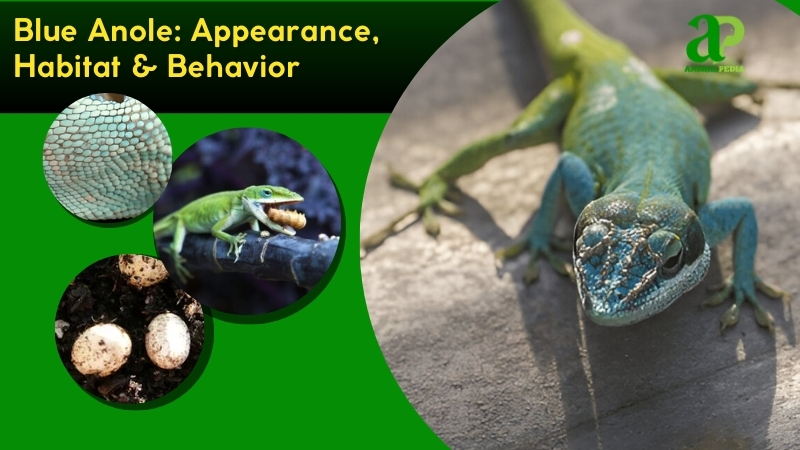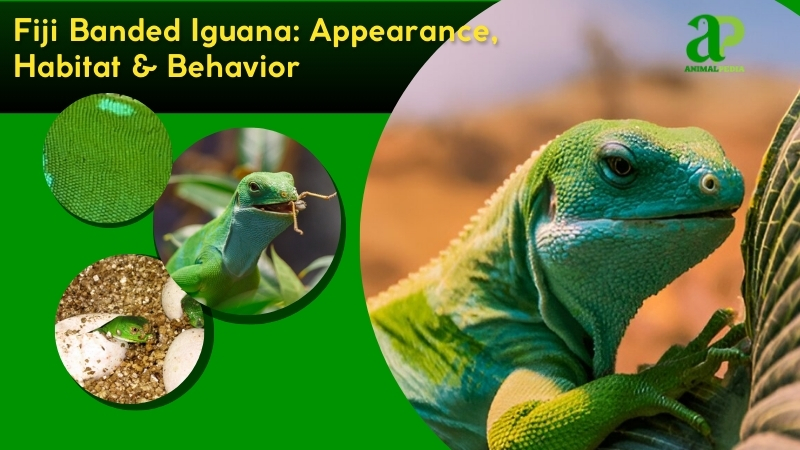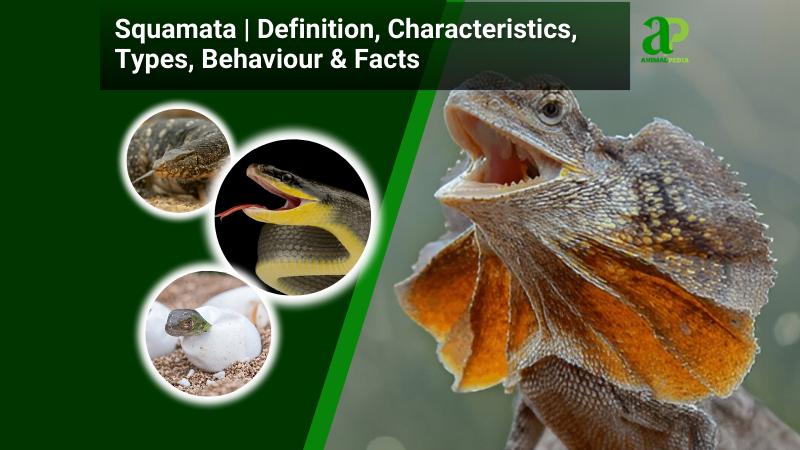The Galapagos Land Iguana (Conolophus subcristatus) inhabits the Galapagos Islands exclusively. These impressive reptiles, also called Galapagos giant iguanas or land dragons, reach lengths up to 1.2 meters, ranking them among the world’s largest land iguana species.
Though herbivorous, these iguanas maintain ecological balance in their native habitat. They primarily consume vegetation—cacti, fruits, and leaves—while occasionally supplementing their diet with insects, centipedes, and carrion. Human encroachment threatens their existence through habitat degradation and direct conflict.
During breeding season, males compete intensely for mates. Females deposit egg clutches in burrows, which incubate for 80-100 days. Hatchlings demonstrate independence, adapting quickly to their environment. These reptiles mature slowly and enjoy a longevity of approximately 60 years in natural settings.
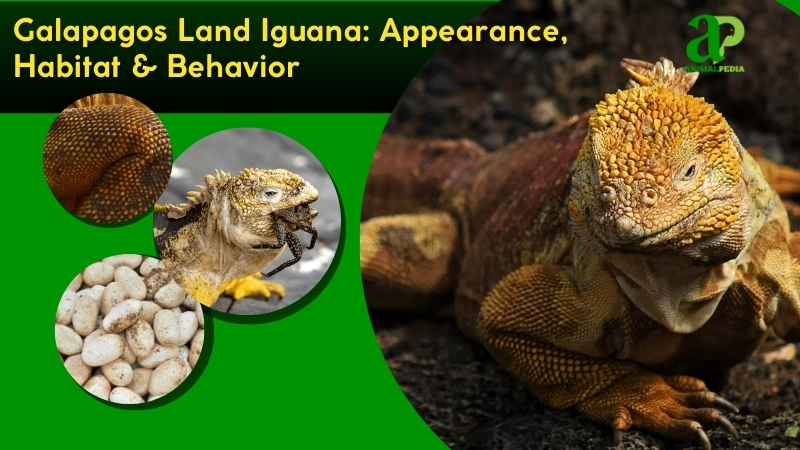
What do the Galapagos Land Iguanas look like?
The Galápagos land iguana grows 3.3–5 feet long and weighs up to 28 pounds. It’s tough, leathery skin features rough scales. The body displays striking yellowish-orange coloration with brown to reddish dorsal areas, often mottled with white, black, or brown patches. This patterning provides natural camouflage in the arid Galápagos environment.
A series of prominent dorsal spines runs from neck to tail, giving the characteristic reptile its distinctive prehistoric appearance. Its short, blunt head houses small, dark eyes and connects to a thick, muscular neck. The iguana possesses a broad, fleshy tongue specialized for consuming Opuntia cacti (prickly-pear), its main food source.

The iguana’s stocky frame rests on powerful limbs equipped with sharp, curved claws for digging burrows. Its tail exceeds the trunk in length, appearing thick at the base and gradually tapering.
Unlike its relative Amblyrhynchus cristatus (marine iguana), the land iguana lacks salt-excreting adaptations and a swimming-specialized tail. It differs from Conolophus pallidus (Santa Fe iguana), which shows paler coloration, and Conolophus Marthae (pink iguana), which exhibits a distinctive rosy hue with black markings. The common land iguana’s vibrant yellow tones make it unmistakable among Galápagos reptiles.
For a Caribbean cousin with heavier build and armored dorsal scales, see the Cuban Rock Iguana
How big do Galapagos Land Iguanas get?
The Galápagos land iguana (Conolophus subcristatus) has an average length of 3.3–5 feet (1–1.5 meters) and weighs around 28 pounds (13 kilograms). These measurements reflect adults across their endemic range in the Galápagos Islands’ dry lowlands. Their robust, cylindrical bodies are adapted for terrestrial life, distinct from their marine relatives.
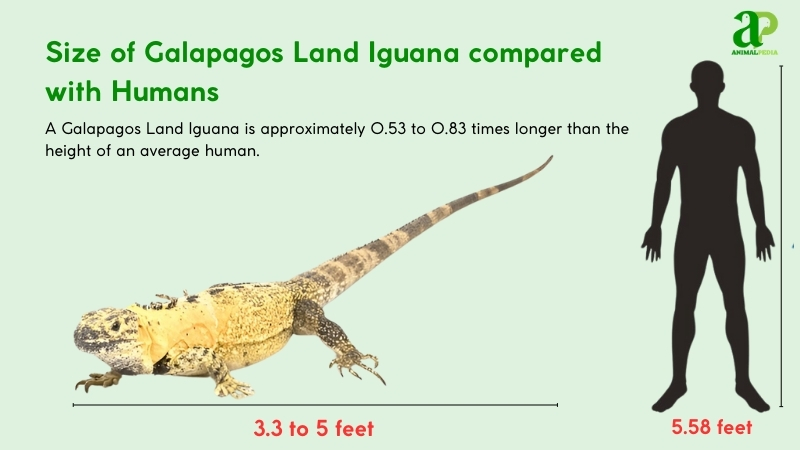
The longest and heaviest recorded specimen reached approximately 5.9 feet (1.8 meters) and 33 pounds (15 kilograms), discovered on Isabela Island, based on field observations by the Charles Darwin Research Station. Adult iguanas typically measure 3–5 feet (0.9–1.5 meters) snout to tail. Males are generally larger, averaging 4–5 feet (1.2–1.5 meters) and 28–30 pounds (13–14 kilograms), while females are slightly smaller at 3–4 feet (0.9–1.2 meters) and 20–25 pounds (9–11 kilograms). This sexual dimorphism aids males in territorial disputes.
| Trait | Male | Female |
| Length (ft) | 4–5 (1.2–1.5 m) | 3–4 (0.9–1.2 m) |
| Weight (lb/kg) | 28–30 / 13–14 | 20–25 / 9–11 |
What are the unique physical characteristics of the Galapagos Land Iguana?
The Galápagos land iguana displays distinctive dorsal spines that set it apart from other iguana species. These conical projections run from neck to tail, forming a prominent crest unlike the flatter spines of marine iguanas or the subtle ridges of common green iguanas. This morphological feature evolved specifically for life on the volcanic Galápagos landscapes.
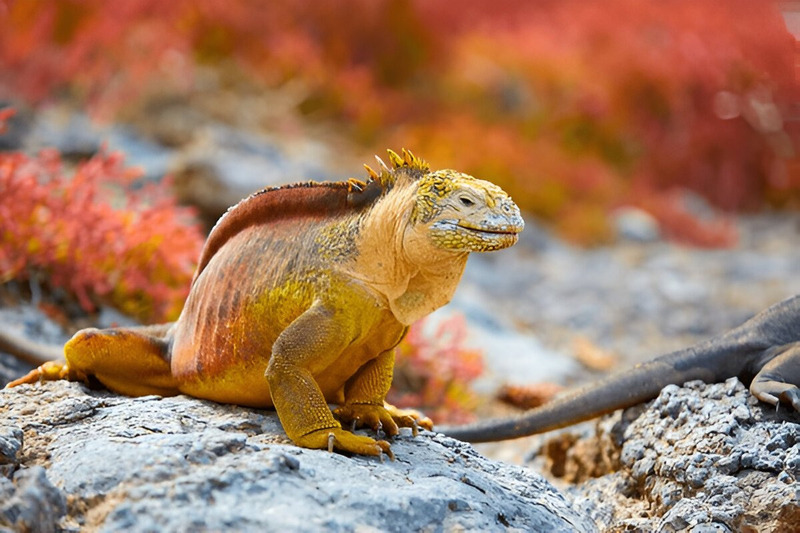
These keratinized spines serve dual purposes: thermoregulation and territorial signaling. The Charles Darwin Research Station’s 2023 research used 3D morphometric analysis to document that males’ spines—typically 1–2 inches (2.5–5 cm) tall—increase in both height and density during breeding season, enhancing their visual profile. The Galápagos land iguana’s crest differs from its relatives: more robust than the C. marthae (pink land iguana) with fewer, wider spines, and more pronounced than C. pallidus (Santa Fe land iguana) with shorter projections.
Evolutionary biologists suggest these spines developed primarily for intraspecific competition and predator deterrence in this unique ecosystem. This adaptation hypothesis gained support from comparative genomic studies published in Evolutionary Biology (2024), highlighting the species’ phenotypic divergence in response to its insular environment.
For a horned, rock-dwelling comparison, see the Rhinoceros Iguana with its bulky build, bony nasal horn, and rugged island habitat.
How do Galapagos Land Iguanas function for their survival?
The Galápagos land iguana survives through specialized adaptations. Prominent dorsal spines serve dual functions: they regulate body temperature and deter predators. These keratinized crests help Conolophus subcristatus absorb and release heat in the harsh, arid volcanic habitats of the Galápagos lowlands. Their imposing profile discourages natural threats like hawks.
Sensory adaptations further enhance survival. Sharp vision helps iguanas spot prickly-pear cacti and other food sources from a distance. Their acute hearing detects subtle predator movements, improving escape chances. A refined olfactory system locates sparse vegetation during dry seasons. Thick, sensitive skin provides tactile feedback for navigating the rocky terrain safely. These combined physiological adaptations allow the species to thrive in challenging environments where resources are limited.
Anatomy
The Galápagos land iguana, a hardy reptile native only to the Galápagos archipelago, has evolved specialized anatomical systems for survival in harsh volcanic terrain:
- Respiratory System: Efficient lungs process air through external nares, via the trachea to alveolar sacs, maximizing oxygen extraction. This supports its distinctive yellowish-orange integument and energy requirements for foraging and thermoregulation through basking behavior.
- Circulatory System: A three-chambered heart with partial ventricular septation—characteristic of Iguanidae—pumps oxygenated blood to powerful appendicular muscles needed for excavating burrows and maintaining its robust morphology.
- Digestive System: Specialized alimentary canal featuring a capacious gastric chamber and elongated intestinal tract processes fibrous Opuntia cacti and xeric vegetation. Strong mandibular apparatus and dentition mechanically break down tough plant materials essential for nutrition.
- Excretory System: Metanephric kidneys produce concentrated uric acid waste, excreted through the cloacal aperture. This adaptation conserves vital water in arid microhabitats, with hydration supplemented by cacti consumption and minimal condensation intake.
- Nervous System: Well-developed encephalon and spinal cord support sensory integration. Acute visual perception detects stimuli at 5-10 meter distances, while the broad lingual organ provides chemosensory information critical for terrestrial navigation and survival.
These anatomical systems enable the iguana’s distinctive dorsal crests, vibrant coloration, and successful adaptation to the challenging Galápagos lowland ecosystem.
Where do Galapagos Land Iguanas live?
Galápagos land iguanas inhabit several islands across the Galápagos archipelago. Their main populations exist on Fernandina, Isabela, Santa Cruz, North Seymour, Baltra, and South Plaza Islands. Scientists successfully reintroduced them to Santiago Island in 2019 after local extinction.

These reptiles thrive in arid lowland zones with volcanic terrain and minimal vegetation. Their habitat features porous lava rock and sparse plant life dominated by prickly-pear cacti (Opuntia species), which form the core of their herbivorous diet and provide vital moisture. The dark volcanic substrate serves as thermal mass for thermoregulation, while the open landscape allows for burrow construction used in both shelter-seeking and nesting behaviors.
The iguanas’ evolutionary history shows site fidelity with no significant migration patterns. They maintain sedentary lifestyles within their island territories. MacLeod’s 2017 genomic research in the Biological Journal of the Linnean Society confirms their long-term endemic status, documenting how these reptiles adapted to the harsh volcanic ecosystem since their evolutionary divergence millions of years ago.
How do seasonal changes affect their behavior?
Land iguanas shift behavior between Galápagos seasons. During the hot, wet season (January–May), these reptiles increase activity. During the cooler, dry season (June–December), they conserve energy in their volcanic habitat.
Male iguanas maintain territories year-round. Their territorial displays intensify during wet months with pronounced head-bobbing and dorsal spine presentations to attract females. Foraging range expands to 30–50 meters daily during wet periods when vegetation flourishes, contracting to 20–30 meters in dry conditions.
Breeding activity peaks during the wet season when resources are abundant. Female iguanas dig burrows for egg-laying, with hatchlings emerging between the late wet and early dry season—a timing that aligns with optimal resource availability. This seasonal adaptation maximizes survival in the archipelago’s harsh environment, where food and water availability fluctuate dramatically.
- Wet Season (January–May)
Activity rises, with iguanas covering 20–30 m2 as cacti fruit in 70–80% humidity and 27–31°C (81–88°F). Basking lasts 1–2 hours, aided by frequent rain.
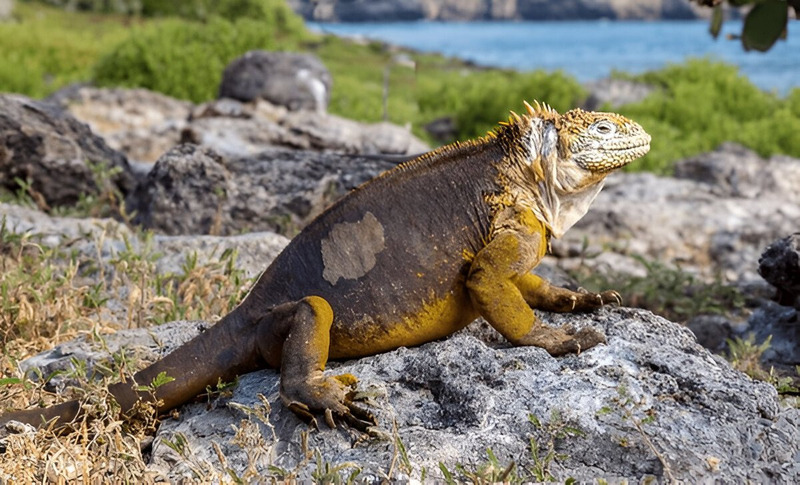
- Dry Season (June–December)
Movement drops 20–30%, conserving energy as food becomes scarce. Basking extends to 3–4 hours in 24–28°C (75–82°F), maximizing heat in drier, cooler conditions (50–60% humidity).
What is the behavior of the Galapagos Land Iguana?
The Galapagos Land Iguana exhibits clear behavioral patterns:
- Diet: Exclusively herbivorous, consuming prickly-pear cactus pads, fruits, and scattered vegetation based on availability and age.
- Foraging: Uses powerful jaws to crush tough plant materials. Rarely supplements its diet with types of insects and carrion when available.
- Activity cycles: Active during daylight hours, especially morning and late afternoon. Spends midday basking to regulate body temperature before resuming foraging.
- Movement: Navigates rocky terrain efficiently with sturdy limbs and sharp claws. Can swim short distances when necessary using lateral body movements.
- Social behavior: Forms loose colonies for protection, with males establishing clear dominance hierarchies and territorial boundaries through displays.
- Communication: Employs head-bobbing, push-ups, and scent marking to signal territorial claims, dominance status, or mating readiness to conspecifics.
What do Galapagos Land Iguanas eat?
The Galápagos land iguana is strictly herbivorous, feeding primarily on prickly-pear cactus (Opuntia spp.)—pads and fruit—along with sparse leaves and flowers in the Galápagos’ arid lowlands. Unlike carnivorous iguanids, it uses its strong jaws and flat teeth to grind tough plant material, foraging terrestrially across volcanic terrain, an adaptation to its cactus-rich habitat.
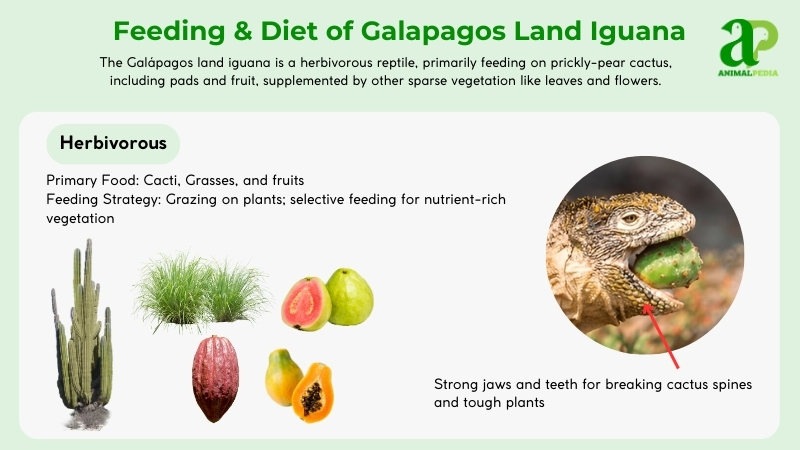
Diet by Age
Diet varies with age, reflecting size and nutritional needs.
- Hatchlings (0–1 Year): Eat soft cactus parts and occasional insects, aiding rapid growth while staying near burrows.
- Juveniles (1–3 Years): Shift to tougher cactus pads, foraging 20–30 meters daily to build resilience.
- Subadults (3–8 Years): Target thicker pads and some fruit, roaming wider to prepare for maturity.
- Adults (8+ Years): Favor cactus fruit and dense vegetation, with males securing prime feeding spots via territorial displays.
Diet by Gender
Males and females eat similarly, biting off chunks and grinding them, lacking chewing adaptations.
Diet by Seasons
As opportunistic herbivores, their diet shifts seasonally. In the wet season (January–May), they feast on abundant cactus fruit; in the dry season (June–December), they rely on pads, adapting to food scarcity.
How do Galapagos Land Iguanas hunt their prey?
The Galápagos land iguana maintains a strictly herbivorous diet. These reptiles feed primarily on prickly-pear cactus (Opuntia species)—consuming both pads and fruit. They also eat sparse leaves and flowers found in the arid lowlands of the Galápagos archipelago.
Unlike their carnivorous relatives, Galápagos land iguanas use strong jaws and flat teeth to grind tough plant material. They forage on foot across volcanic terrain, an evolutionary adaptation that allows them to thrive in their cactus-dominated habitat. This specialized feeding behavior helps them survive in an environment where vegetation is limited.

While they’re primarily herbivores, Galapagos Land Iguanas are opportunistic omnivores and may occasionally consume invertebrates like centipedes or carrion.
Although they don’t engage in traditional hunting behavior, Galapagos Land Iguanas play a vital role in their ecosystem by sustaining themselves on the plant life around them. Their diet of plants, including cacti, helps maintain the ecological balance of their environment.
Are Galapagos Land Iguanas venomous?
Galapagos Land Iguanas lack venom glands. Rather than using toxins for defense, these reptiles rely on alternative survival strategies in their natural habitat. They maintain non-aggressive behavior toward humans and other animals, preferring to bask in sunlight and consume plant matter instead of engaging in confrontational interactions.
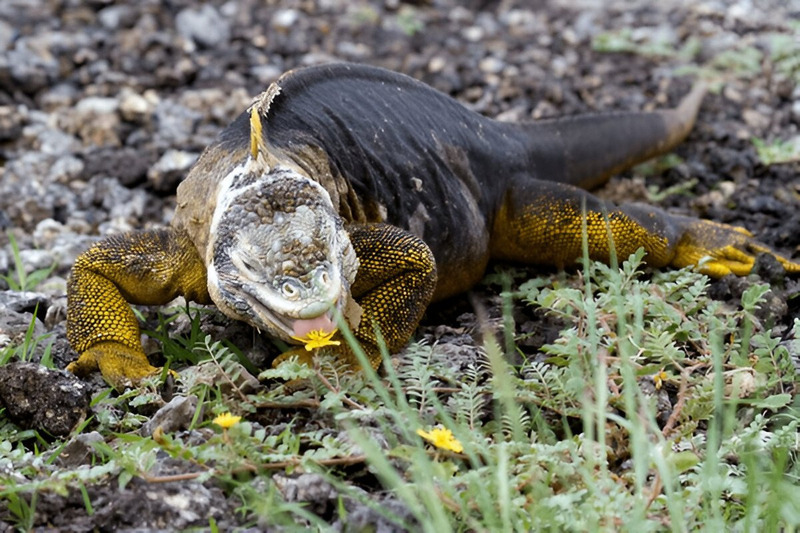
These reptiles can be observed moving slowly through the arid lowlands across various Galapagos Islands, harmoniously existing within their unique ecosystem. Their docile temperament makes watching Galapagos Land Iguanas in their natural environment a peaceful and enriching wildlife experience.
Despite their formidable appearance with muscular bodies and spiny dorsal crests, these endemic creatures contribute to the wonder of the Galapagos archipelago, demonstrating their evolutionary adaptations as they navigate their volcanic island homes.
When are Galapagos Land Iguanas most active during the day?
Galapagos Land Iguanas are most active during the early morning and late afternoon hours. These endemic reptiles (Conolophus subcristatus) bask in the sunlight to raise their body temperature and prepare for daily activities in the morning. During midday heat, they retreat to shaded areas to conserve energy and regulate their thermophysiology.
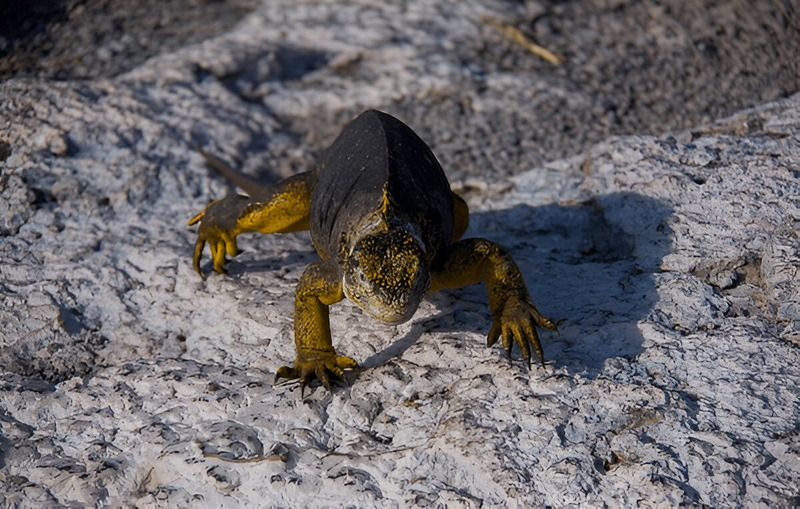
As temperatures cool in the late afternoon, they resume activity, primarily foraging for prickly pear cactus pads and other vegetation or engaging in territorial behaviors. This crepuscular activity pattern represents a behavioral adaptation to the equatorial climate of the Galapagos archipelago.
For wildlife observers visiting these UNESCO World Heritage islands, the optimal viewing windows occur during these bimodal activity periods – shortly after sunrise and before sunset – when these prehistoric-looking saurians display their natural behaviors across their volcanic habitat.
How do Galapagos Land Iguanas move on land and water?
Galapagos Land Iguanas move with distinct patterns across terrestrial and aquatic environments. On land, these endemic reptiles display a lateral undulation gait, using their powerful limbs and sharp claws to navigate rocky terrain and sandy beaches efficiently. Their quadrupedal locomotion allows them to traverse volcanic landscapes, while their splayed posture provides stability on uneven surfaces.
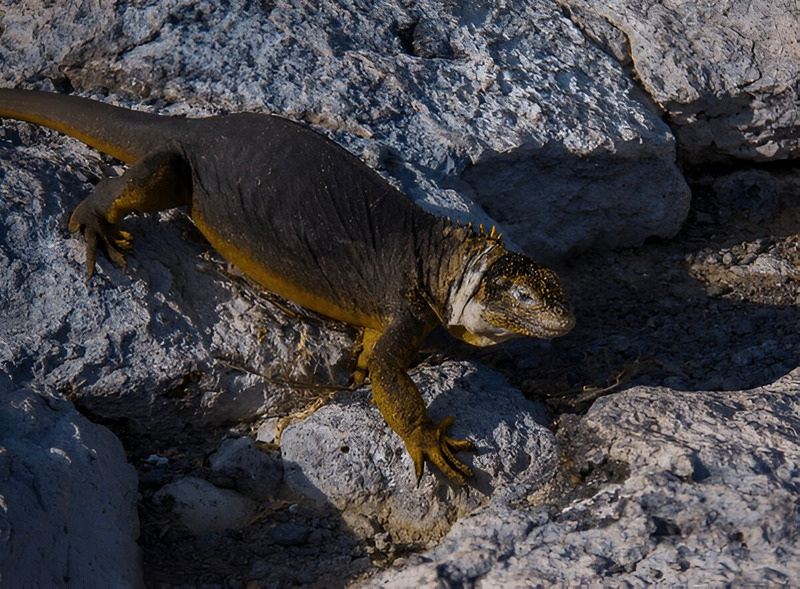
Though primarily terrestrial, Galapagos Land Iguanas possess limited aquatic mobility. When necessary, they employ a doggy-paddle technique with their front limbs while their muscular tail provides propulsion through side-to-side movements. Unlike their marine counterparts, these iguanas don’t seek water but can cross short channels between islands when required.
Their thermoregulatory behavior influences movement patterns throughout the day. Morning hours see slow, deliberate motion as they warm their ectothermic bodies. By midday, they achieve peak mobility with quick bursts of speed reaching up to 12 mph during territorial disputes or predator evasion.
The biomechanics of their movement reveal evolutionary adaptations specific to the Galapagos archipelago’s unique ecological niches, demonstrating the species’ phenotypic plasticity in response to insular environments.
Do Galapagos Land Iguanas live alone or in groups?
Galapagos Land Iguanas display territorial behavior with social aspects. Unlike marine iguanas, these reptiles form small colonies in their arid habitats. This successful adaptation to a harsh, dry environment is a theme shared with the famous Desert Iguana of the American mainland, though their social structures differ.
In these colonies, iguanas share communal activities like basking and burrow use. Despite their fierce appearance, these endemic reptiles engage in non-verbal communication and maintain clear dominance hierarchies within their groups.

The colonies contain mixed demographics of various ages and sexes. Juvenile iguanas observe adults to learn survival skills, while mature males establish and defend territories through ritualized displays.
This colonial lifestyle helps these Conolophus species survive in the harsh Galapagos environment. Their social structure demonstrates natural adaptation strategies. When observing Galapagos Land Iguanas, note both their distinctive appearance and their complex social interactions that define their existence.
How do Galapagos Land Iguanas communicate with each other?
Galapagos Land Iguanas use non-verbal communication to interact with each other. These endemic reptiles rely on visual displays and chemical signals rather than vocalizations.
Head bobbing, tail flicking, and postural changes form their primary communication system. Males bob their heads to establish dominance hierarchies or signal mating interest. When two territorial iguanas encounter each other, they perform ritualized displays to resolve conflicts without physical combat. They may expand their dewlaps or change body coloration to signal their intentions.
Chemical communication plays an equally vital role in iguana society. They possess femoral pores on their hind legs that secrete pheromones, creating a unique chemical signature. These olfactory markers help establish territorial boundaries and broadcast reproductive readiness to potential mates.
The sophisticated communication system of Conolophus subcristatus and related Galapagos iguana species demonstrates the evolutionary adaptations these reptiles have developed. Their signaling mechanisms maintain social order while conserving energy in their harsh volcanic habitat.
How do Galapagos Land Iguanas reproduce?
Galápagos land iguanas reproduce sexually. Breeding season begins during the wet months (January–May). Males establish territories, display enlarged dorsal spines, and perform head-bobbing rituals to attract females. Females signal receptivity by approaching males. They engage in courtship through physical nudges and circling behavior before copulation occurs.
After mating, females dig burrows 30–60 cm deep in sandy soil where they deposit 2–20 eggs. Each egg weighs 80–100 grams. Females cover nests with soil for protection, guard briefly, then leave. Males depart immediately after mating. Environmental factors like drought or predation can interrupt egg-laying, as documented in Traveset’s 2019 Isabela Island research.
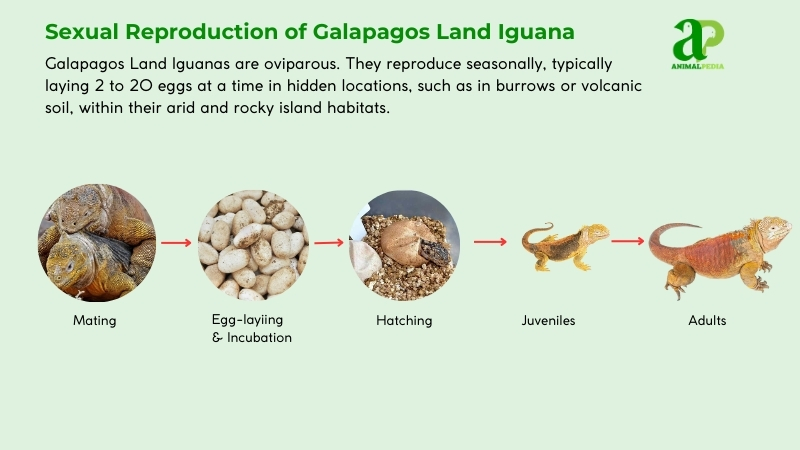
Incubation lasts 90–120 days. Hatchlings emerge 10–15 cm long, completely independent, and feed primarily on soft cactus tissue. They grow rapidly during their first years. The reproductive cycle continues throughout their 40–60-year lifespan. Sexual maturity arrives at 8–12 years, according to a 2018 study published in Ecology and Evolution. Habitat degradation represents a significant threat to their reproductive success.
How long do Galapagos Land Iguanas live?
Galápagos land iguanas typically live 40-60 years in their natural habitat. These reptiles reach sexual maturity between 8-12 years of age. Young iguanas develop quickly, though their population faces significant threats from habitat destruction and non-native predators, according to comprehensive 2018 research published in Ecology and Evolution.
Wild specimens have a median lifespan of approximately 50 years, with similar longevity observed in both sexes. However, male mortality rates may increase due to territorial conflicts. In protected captive environments, these reptiles (Conolophus subcristatus) frequently survive beyond 60 years when provided optimal husbandry conditions and veterinary care.
What are the threats or predators that Galapagos Land Iguanas face today?
Galapagos land iguanas (Conolophus subcristatus) face five major threats today: invasive predators, habitat destruction, climate shifts, human interference, and native predation.
- Invasive species devastate iguana populations. Feral cats and dogs hunt adult and juvenile iguanas, while introduced rats and pigs raid nests. These non-native predators have cut iguana numbers by half on islands like Santiago, according to 2019 research.
- Habitat loss threatens survival directly. Non-native goats devour Opuntia cacti—the iguanas’ primary food source—destroying both nutrition and nesting habitat. This causes malnutrition and breeding failure, particularly on Isabela Island.
- Climate change impacts food availability severely. El Niño droughts kill cacti, reducing iguana survival rates by 20-30% during extreme weather events.
- Tourism pressure harms reproduction success. Over 200,000 yearly visitors create disturbances, with foot traffic crushing nests and reducing egg viability by 10-15% in popular areas like South Plaza Island.
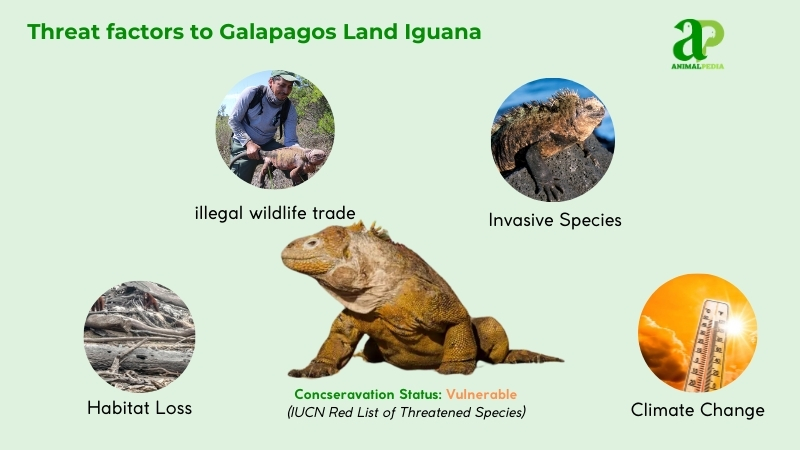
Predation varies by life stage. Introduced mammals (cats, dogs, pigs) target adults and juveniles, while rats attack eggs. Native Galapagos hawks hunt hatchlings, though this natural predation causes less damage due to evolutionary adaptation.
Conservation efforts show promise. After feral animal control programs and reintroduction initiatives, populations have rebounded from near extinction to over 1,000 individuals on Santiago since 2019, as documented by Coloma et al. in Conservation Biology (2020). Despite progress, the species is vulnerable.
Are Galapagos Land Iguanas endangered?
The Galápagos land iguana, Vulnerable on the IUCN Red List, is not endangered. This classification reflects real threats despite ongoing protection efforts.
The IUCN gave this Vulnerable (VU) status in 2017 based on habitat loss, invasive predators, and climate shifts. Though not facing immediate extinction, the iguana’s limited range and declining numbers on islands like Baltra and Santiago warrant concern. Conservation programs have reduced extinction risk, but continued monitoring is essential.
Current population estimates range from 8,000-10,000 specimens across the archipelago. Isabela Island hosts the largest group (approximately 5,000), while Santiago’s reintroduced population reaches about 1,200, according to Coloma’s 2020 Conservation Biology research. Santa Cruz maintains 2,000-3,000 iguanas, but smaller islands like South Plaza support fewer than 100. These figures derive from field surveys and mark-recapture techniques, showing recovery from historical lows when Santiago had fewer than 500 individuals before 2019. Traveset’s 2019 Journal of Herpetology study confirms these positive trends, noting how successful control of feral species has boosted population numbers.
What conservation efforts are underway?
The Galápagos land iguana (Conolophus subcristatus) benefits from targeted conservation efforts led by the Galápagos National Park Directorate (GNPD) and Galápagos Conservancy. A key initiative, the Galápagos Land Iguana Project, began reintroducing iguanas to Santiago Island in 2019, restoring a population extinct there since the early 20th century. By 2024, over 3,500 iguanas have been translocated, with monitoring ongoing since 2018.
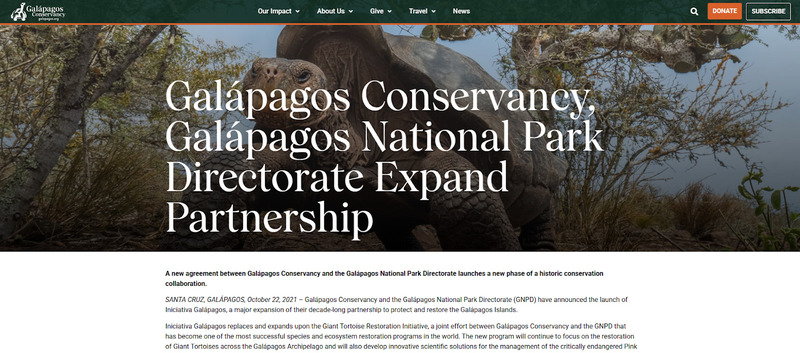
Frequently Asked Questions
Can Galapagos Land Iguanas Change Color Like Some Other Species of Lizards?
Yes, Galapagos land iguanas can’t change color like some lizards. Their appearance stays constant. These creatures, endemic to the islands, display distinctive yellow and brownish-red hues described by Charles Darwin.
How Do Galapagos Land Iguanas Communicate With Each Other?
To communicate, Galapagos land iguanas use head bobs, push-ups, and hisses. These gestures convey dominance or submission, territorial boundaries, and mating readiness. They also communicate through visual displays to warn or attract others, expressing their diverse behaviors.
Do Galapagos Land Iguanas Have Any Unique Adaptations to Their Environment?
Yes, they rely on basking to regulate body temperature, take moisture from cactus to survive, show opportunistic feeding behavior, enjoy mutualism with birds, and reproduce successfully.
Are There Any Specific Conservation Efforts in Place to Protect Galapagos Land Iguanas?
There are active conservation efforts in place to protect Galapagos land iguanas. You’ll be glad to know that initiatives include reintroduction campaigns on Baltra Island to increase their population and safeguard their existence.
What Role Do Galapagos Land Iguanas Play in the Ecosystem of the Galapagos Islands?
In the Galapagos Islands, Galapagos land iguanas play an essential role in the ecosystem by controlling vegetation growth, dispersing seeds, and providing food for predators. Their presence contributes to the balance and biodiversity of the region.
Conclusion
So, isn’t it engrossing to learn about the Galapagos Land Iguana? These unique creatures with their spiny backs, vibrant colors, and long lifespans are truly enthralling. From their sunbathing habits to their diet of cactus, there’s so much to admire about these incredible reptiles. Next time you think about biodiversity, remember the Galapagos Land Iguana and the amazing adaptations that have helped them thrive in their island homes.





